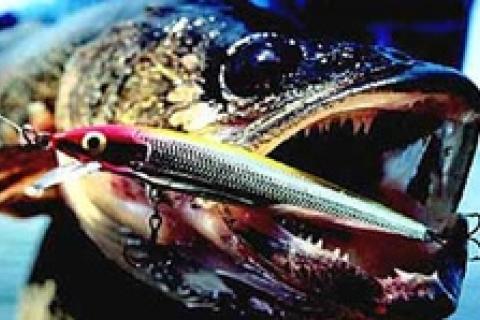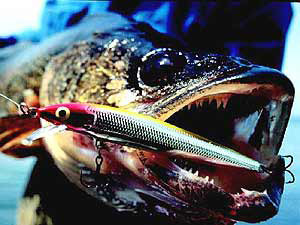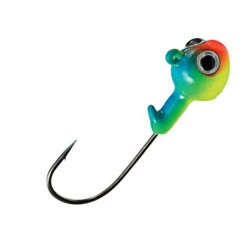
 Ranking second in popularity only to the largemouth bass, the walleye has become a fan favorite for anglers that ply the water across all of North America. Not only do they put up a moderate fight consisting of heavy pulls and headshakes, they also taste delicious when served piping hot, fresh out of the pan. Knowing what equipment and lures to use when out on the water can pay big dividends in terms of quantity and quality of fish, making life in the boat much more fun and enjoyable. Follow me as I outline the necessary requirements to do battle with Mr. Sander vitreus — the name may sound complicated, but the act of catching one certainly doesn't have to be.
Ranking second in popularity only to the largemouth bass, the walleye has become a fan favorite for anglers that ply the water across all of North America. Not only do they put up a moderate fight consisting of heavy pulls and headshakes, they also taste delicious when served piping hot, fresh out of the pan. Knowing what equipment and lures to use when out on the water can pay big dividends in terms of quantity and quality of fish, making life in the boat much more fun and enjoyable. Follow me as I outline the necessary requirements to do battle with Mr. Sander vitreus — the name may sound complicated, but the act of catching one certainly doesn't have to be.
Rods, Reels & Line
Selecting a fishing rod and reel for chasing walleye shouldn't be a difficult task. By knowing what to look for in terms of quality and construction, you will be able to narrow down your choices and zero-in on that perfect combination.
A spinning rod and reel is the first component in the selection process. A rod of this nature will allow you to work jigs and light cranks — two mainstays in the walleye angler's arsenal. A medium-action graphite rod that is between 6.5 and 7 feet long will nicely do the trick, especially when teemed up with a high-quality spinning reel that is rated for 8- or 10-pound test line. (Monofilament is my preferred line to use.)
Make sure that the reel you choose has an extremely smooth drag, as this will be necessary when doing battle with a fish. Another tip is to choose a rod that has increased sensitivity in the upper third of the rod, while having a reasonable amount of backbone in the lower half. These qualities will enable you to react to light biters, while also playing fish to the boat with ease.
Having a baitcast rod and reel at your disposal will enable you to use heavier line and bigger lures. I like to choose a medium-action graphite rod in the 7-foot range, coupled with a good quality baitcaster and 12- or 14-pound test line. This style of rod will lend itself perfectly for trolling, casting and bottom-bouncing applications.
Braided line can provide thinner diameter, lower stretch and added sensitivity — a definite plus when dealing with Mr. Walleye.
What to Throw
 |
| The jig ranks number one in popularity and fish-catching prowess. |
When it comes to tying something onto the end of your line, there are a multitude of baits, lures and gizmos saturating the market. Many will eventually find their rightful place in your tackle box, but for now, there are certain kinds that have a proven track record, and these are the ones you need to pick up first.
Walleye Fishing Jigs
Jigs are synonymous with walleye for one good reason — they catch fish. Undoubtedly, across all of North America, the jig ranks number one in popularity and fish-catching prowess.
The common jig is made up of two parts — a lead-headed weight that is molded onto a hook, and a plastic or livebait 'trailer' that is attached to the hook. (We'll discuss trailers in detail later in the article.) Quite simple in principle, but lethal when used the right way.
When purchasing a jig head, there are three main components to delve into: these are weight, style, and hook composition.
Weight & Size of Fishing Jig
Jigs are worked directly on the bottom structure of the lake, river or stream you are fishing. Since they need to remain in steady contact with the lakebed, recognizing what size weight you need to choose is paramount. For water less than 10 feet, selecting an 1/8-ounce size would be your best bet. As you move upwards of twenty-feet in the depth chart, a 1/4-ounce jig head would be the best option to tie on. Over twenty-feet and the ideal selection would be a 3/8- or 1/2-ounce model. (Keep in mind that wind and rough weather will dictate a change to a heavier jig in order to maintain feel and contact with the bottom.)
Style of Jig Head
Jig heads come in a variety of styles, each catering to a different function or action. Owning a few different types will allow you the option of fishing "differently" while using the same basic lure.
Round-headed or ball-headed jigs are the most common purchase for walleye anglers. As the name suggests, this weight is completely spherical in shape, a design trait that allows easy movement over the bottom structure you are fishing. Choose an assortment of these in varying sizes, paying careful attention to purchase those that have a "bait-holding collar" on the shaft of the lead. (This will help in keeping your plastics from sliding down the hook shank.)
Stand-Up jig heads are another excellent walleye bait, as their design enables the lure to "stand" vertically in the water column at rest -- an enticing trait for a hungry walleye to hone in on. Pick up a few of these for flat bottom areas, or for the times when the fish are feeling finicky.
Darter jig heads mimic the action of a wounded baitfish, in turn allowing increased movement through quick changes of direction and action. These are a great choice when the walleye are really wound up, or when they need something a little different in order to get their attention.
Choosing the Right Fishing Hook
When selecting jig heads, one key to remember is hook composition. Make sure the hook is of a premium quality, needle sharp and ultra strong. Walleye have bony mouths, so ensuring hook penetration is the name of the game when dealing with jigs.
Other jigs that deserve a place in your box are bucktails, weedless jig heads (for heavy cover) and tube jigs. This should cover most of the applications you will encounter when jigging through the depths.
 |
| Adding plastic bait to your hook provides action, scent, color and feel to the jig head. |
Partnering Up the Jig
Jig heads require one other ingredient in order to make them complete, and this comes in the form of a plastic trailer or livebait. Tipping a jig head with livebait is very simple — hook a minnow or thread a worm and you are ready to fish.
When selecting plastics to trailer your hook, a simple grub-style or twister tail are the most popular and widely used. Adding a plastic bait to your hook provides action, scent, color and feel to the jig head, ultimately making it a fish-catching phenom.
There are many different color combinations on the market when it comes to plastic grubs and twister tails, but a few select hues should always be represented in your arsenal. White, chartreuse, orange, black and perch will all work wonders for garnering a walleye's attention, so be sure to stock up on a few packages of each. Be sure to choose a plastic impregnated with scent; this will help mask offending odors, while also sending out attractive smells and taste to fish.
Crankbaits
Crankbaits are mandatory in every tackle box becasue they catch tons of fish — plain and simple. They mimic the action and look of the main prey that walleye feed on — other fish — and incite a feeding response and attack that is second to none. They also allow you to cover a larger area of the "playing field," meaning that more fish will ultimately see your bait swim by.
Choosing a crankbait from the hundreds of varieties that are offered can be nerve wracking, but knowing precisely what to look for will make the task simple and easy.
Crankbait Shape & Size
When selecting the perfect crank, thin is definitely the way to go. Walleye prefer long, thin fish as a food source, (in comparison to bass), and choosing this variety will put the odds in your favor. Stocking up on cranks that range in length from three-and-a-half to six-inches in length will enable you to cover all the conditions that you will be faced with. (As the old adage goes, the warmer the water, the larger the bait to throw!)
Crankbait Diving Depths
In order to reach the walleye of the deep, a crankbait that will dive down to the desired depth where the fish lurk is imperative. Walleye may be found in a wide variety of depths on each given lake and river, hence, having a variety of shallow, medium and deep-diving crankbaits is your best option to choose. Figuring out where the fish are located (often through the use of sonar) will enable you to pick the appropriate diving model in order to target that particular depth.
Crankbait Color
Much like plastics, there are certain colors that walleye will relate to better when applied to crankbaits. Perch, chartreuse, silver, blue and red will all work wonders, as will more natural shades when facing clear-water conditions.
I also like to choose baits that have built-in rattles. This "chamber of sound" will draw fish in from afar, leading to more strikes from interested and curious walleye.
 |
| Bottom bouncers and walker sinkers allow you to present bait along the bottom. |
Bottom Bouncers & Walkers
Walleye are known for hugging the bottom in most water systems of North America. In order to do battle, many times it is necessary to get your offering directly in their strike zone. (This is also why jigs work so well.)
Bottom bouncers and walking sinkers allow you to present your bait (usually in the form of a crawler, minnow or leech) along the bottom, allowing the walleye to intercept it with ease. Carrying an assortment of bottom bouncers and walker sinkers in varying weights (depending on the depth you are targeting) will enable you to cover this productive fish area perfectly.
The one missing component when dealing with bottom bouncers is the spinner rig. This will be attached to the lead portion or arm of the mechanism itself.
Having a few varieties of spinner rigs — assorted colors, varying sizes and blade shapes — will allow you to cover all the bases, as will tipping them with a wide variety of live baits. Throw in some floating jigs for use with walking sinkers, and get ready for some fast and fun action.
As you can see, selecting the appropriate tackle for chasing walleye doesn't have to be a game of chance. With the right tools and a little knowledge, you're almost guaranteed to put a few fish in the boat! Good luck and great fishing.
- 66298 views

